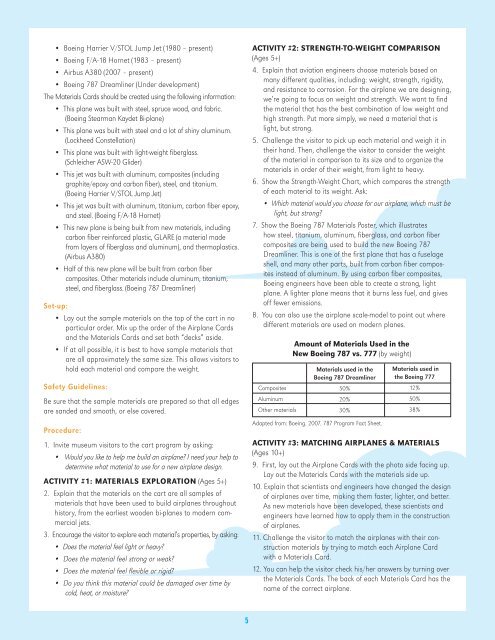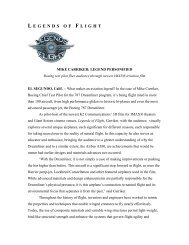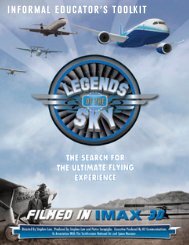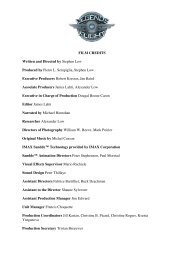download - Legends of Flight
download - Legends of Flight
download - Legends of Flight
Create successful ePaper yourself
Turn your PDF publications into a flip-book with our unique Google optimized e-Paper software.
• Boeing Harrier V/STOL Jump Jet (1980 – present)<br />
• Boeing F/A-18 Hornet (1983 – present)<br />
• Airbus A380 (2007 – present)<br />
• Boeing 787 Dreamliner (Under development)<br />
The Materials Cards should be created using the following information:<br />
• This plane was built with steel, spruce wood, and fabric.<br />
(Boeing Stearman Kaydet Bi-plane)<br />
• This plane was built with steel and a lot <strong>of</strong> shiny aluminum.<br />
(Lockheed Constellation)<br />
• This plane was built with light-weight fiberglass.<br />
(Schleicher ASW-20 Glider)<br />
• This jet was built with aluminum, composites (including<br />
graphite/epoxy and carbon fiber), steel, and titanium.<br />
(Boeing Harrier V/STOL Jump Jet)<br />
• This jet was built with aluminum, titanium, carbon fiber epoxy,<br />
and steel. (Boeing F/A-18 Hornet)<br />
• This new plane is being built from new materials, including<br />
carbon fiber reinforced plastic, GLARE (a material made<br />
from layers <strong>of</strong> fiberglass and aluminum), and thermoplastics.<br />
(Airbus A380)<br />
• Half <strong>of</strong> this new plane will be built from carbon fiber<br />
composites. Other materials include aluminum, titanium,<br />
steel, and fiberglass. (Boeing 787 Dreamliner)<br />
Set-up:<br />
• Lay out the sample materials on the top <strong>of</strong> the cart in no<br />
particular order. Mix up the order <strong>of</strong> the Airplane Cards<br />
and the Materials Cards and set both “decks” aside.<br />
• If at all possible, it is best to have sample materials that<br />
are all approximately the same size. This allows visitors to<br />
hold each material and compare the weight.<br />
Safety Guidelines:<br />
Be sure that the sample materials are prepared so that all edges<br />
are sanded and smooth, or else covered.<br />
Procedure:<br />
1. Invite museum visitors to the cart program by asking:<br />
• Would you like to help me build an airplane? I need your help to<br />
determine what material to use for a new airplane design.<br />
ACTIVITY #1: MATERIALS EXPLORATION (Ages 5+)<br />
2. Explain that the materials on the cart are all samples <strong>of</strong><br />
materials that have been used to build airplanes throughout<br />
history, from the earliest wooden bi-planes to modern commercial<br />
jets.<br />
3. Encourage the visitor to explore each material’s properties, by asking:<br />
• Does the material feel light or heavy?<br />
• Does the material feel strong or weak?<br />
• Does the material feel flexible or rigid?<br />
• Do you think this material could be damaged over time by<br />
cold, heat, or moisture?<br />
ACTIVITY #2: STRENGTH-TO-WEIGHT COMPARISON<br />
(Ages 5+)<br />
4. Explain that aviation engineers choose materials based on<br />
many different qualities, including: weight, strength, rigidity,<br />
and resistance to corrosion. For the airplane we are designing,<br />
we’re going to focus on weight and strength. We want to find<br />
the material that has the best combination <strong>of</strong> low weight and<br />
high strength. Put more simply, we need a material that is<br />
light, but strong.<br />
5. Challenge the visitor to pick up each material and weigh it in<br />
their hand. Then, challenge the visitor to consider the weight<br />
<strong>of</strong> the material in comparison to its size and to organize the<br />
materials in order <strong>of</strong> their weight, from light to heavy.<br />
6. Show the Strength-Weight Chart, which compares the strength<br />
<strong>of</strong> each material to its weight. Ask:<br />
• Which material would you choose for our airplane, which must be<br />
light, but strong?<br />
7. Show the Boeing 787 Materials Poster, which illustrates<br />
how steel, titanium, aluminum, fiberglass, and carbon fiber<br />
composites are being used to build the new Boeing 787<br />
Dreamliner. This is one <strong>of</strong> the first plane that has a fuselage<br />
shell, and many other parts, built from carbon fiber composites<br />
instead <strong>of</strong> aluminum. By using carbon fiber composites,<br />
Boeing engineers have been able to create a strong, light<br />
plane. A lighter plane means that it burns less fuel, and gives<br />
<strong>of</strong>f fewer emissions.<br />
8. You can also use the airplane scale-model to point out where<br />
different materials are used on modern planes.<br />
Composites<br />
Aluminum<br />
Other materials<br />
Amount <strong>of</strong> Materials Used in the<br />
New Boeing 787 vs. 777 (by weight)<br />
Materials used in the<br />
Boeing 787 Dreamliner<br />
50%<br />
20%<br />
30%<br />
Adapted from: Boeing. 2007. 787 Program Fact Sheet.<br />
Materials used in<br />
the Boeing 777<br />
12%<br />
50%<br />
38%<br />
ACTIVITY #3: MATCHING AIRPLANES & MATERIALS<br />
(Ages 10+)<br />
9. First, lay out the Airplane Cards with the photo side facing up.<br />
Lay out the Materials Cards with the materials side up.<br />
10. Explain that scientists and engineers have changed the design<br />
<strong>of</strong> airplanes over time, making them faster, lighter, and better.<br />
As new materials have been developed, these scientists and<br />
engineers have learned how to apply them in the construction<br />
<strong>of</strong> airplanes.<br />
11. Challenge the visitor to match the airplanes with their construction<br />
materials by trying to match each Airplane Card<br />
with a Materials Card.<br />
12. You can help the visitor check his/her answers by turning over<br />
the Materials Cards. The back <strong>of</strong> each Materials Card has the<br />
name <strong>of</strong> the correct airplane.<br />
5





